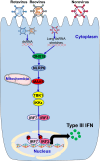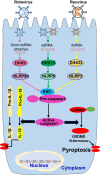Mechanisms involved in controlling RNA virus-induced intestinal inflammation
- PMID: 35604464
- PMCID: PMC9125963
- DOI: 10.1007/s00018-022-04332-z
Mechanisms involved in controlling RNA virus-induced intestinal inflammation
Abstract
Gastroenteritis is inflammation of the lining of stomach and intestines and causes significant morbidity and mortality worldwide. Many viruses, especially RNA viruses are the most common cause of enteritis. Innate immunity is the first line of host defense against enteric RNA viruses and virus-induced intestinal inflammation. The first layer of defense against enteric RNA viruses in the intestinal tract is intestinal epithelial cells (IECs), dendritic cells and macrophages under the intestinal epithelium. These innate immune cells express pathogen-recognition receptors (PRRs) for recognizing enteric RNA viruses through sensing viral pathogen-associated molecular patterns (PAMPs). As a result of this recognition type I interferon (IFN), type III IFN and inflammasome activation occurs, which function cooperatively to clear infection and reduce viral-induced intestinal inflammation. In this review, we summarize recent findings about mechanisms involved in enteric RNA virus-induced intestinal inflammation. We will provide an overview of the enteric RNA viruses, their RNA sensing mechanisms by host PRRs, and signaling pathways triggered by host PRRs, which shape the intestinal immune response to maintain intestinal homeostasis.
Keywords: Caspase; Cytokine; Diarrhea; Enterocyte; PARP9; Pyroptosis; RNA helicase; SARS-CoV-2.
© 2022. The Author(s), under exclusive licence to Springer Nature Switzerland AG.
Conflict of interest statement
The authors declare no conflict of interests.
Figures




Similar articles
-
Enteric Virome Sensing-Its Role in Intestinal Homeostasis and Immunity.Viruses. 2018 Mar 23;10(4):146. doi: 10.3390/v10040146. Viruses. 2018. PMID: 29570694 Free PMC article. Review.
-
DHX15 is required to control RNA virus-induced intestinal inflammation.Cell Rep. 2021 Jun 22;35(12):109205. doi: 10.1016/j.celrep.2021.109205. Cell Rep. 2021. PMID: 34161762 Free PMC article.
-
Identification of the RNA Pseudoknot within the 3' End of the Porcine Reproductive and Respiratory Syndrome Virus Genome as a Pathogen-Associated Molecular Pattern To Activate Antiviral Signaling via RIG-I and Toll-Like Receptor 3.J Virol. 2018 May 29;92(12):e00097-18. doi: 10.1128/JVI.00097-18. Print 2018 Jun 15. J Virol. 2018. PMID: 29618647 Free PMC article.
-
RNA sensors of the innate immune system and their detection of pathogens.IUBMB Life. 2017 May;69(5):297-304. doi: 10.1002/iub.1625. Epub 2017 Apr 4. IUBMB Life. 2017. PMID: 28374903 Free PMC article. Review.
-
Expression of Ifnlr1 on Intestinal Epithelial Cells Is Critical to the Antiviral Effects of Interferon Lambda against Norovirus and Reovirus.J Virol. 2017 Mar 13;91(7):e02079-16. doi: 10.1128/JVI.02079-16. Print 2017 Apr 1. J Virol. 2017. PMID: 28077655 Free PMC article.
Cited by
-
Immune Responses of Dendritic Cells to Zoonotic DNA and RNA Viruses.Vet Sci. 2025 Jul 24;12(8):692. doi: 10.3390/vetsci12080692. Vet Sci. 2025. PMID: 40872644 Free PMC article. Review.
-
TRIM18 is a critical regulator of viral myocarditis and organ inflammation.J Biomed Sci. 2022 Jul 31;29(1):55. doi: 10.1186/s12929-022-00840-z. J Biomed Sci. 2022. PMID: 35909127 Free PMC article.
-
Viroporins Manipulate Cellular Powerhouses and Modulate Innate Immunity.Viruses. 2024 Feb 23;16(3):345. doi: 10.3390/v16030345. Viruses. 2024. PMID: 38543711 Free PMC article. Review.
-
The immune system in cardiovascular diseases: from basic mechanisms to therapeutic implications.Signal Transduct Target Ther. 2025 May 23;10(1):166. doi: 10.1038/s41392-025-02220-z. Signal Transduct Target Ther. 2025. PMID: 40404619 Free PMC article. Review.
-
TRIM29 controls enteric RNA virus-induced intestinal inflammation by targeting NLRP6 and NLRP9b signaling pathways.Mucosal Immunol. 2025 Feb;18(1):135-150. doi: 10.1016/j.mucimm.2024.10.004. Epub 2024 Oct 11. Mucosal Immunol. 2025. PMID: 39396665 Free PMC article.
References
-
- Black RE, et al. Global, regional, and national causes of child mortality in 2008: a systematic analysis. Lancet. 2010;375(9730):1969–1987. - PubMed
Publication types
MeSH terms
Substances
Grants and funding
LinkOut - more resources
Full Text Sources
Research Materials
Miscellaneous

